Workplace safety is a crucial aspect of every industry, but it is especially important in the F&B industry. The F&B industry is responsible for the production, storage, and distribution of food and beverages to the public, and it is essential to ensure the safety and quality of these products to prevent harm to customers and employees.
In this article, we will explore the definition of workplace safety and its importance, as well as provide a list of the eight best practices for occupational safety and health in the F&B industry.
The Definition of Workplace Safety

Workplace safety refers to the measures that are taken to ensure the health and well-being of employees in the workplace. This includes physical safety, such as preventing accidents and injuries, as well as ensuring that employees are not exposed to hazardous substances or conditions.
Additionally, this workplace safety program also encompasses mental safety, such as reducing stress and preventing burnout, and environmental safety, such as reducing pollution and waste.
The goal of workplace safety is to prevent injuries, illnesses, and fatalities in the workplace, as well as to create a healthy and safe work environment for employees. This is accomplished through the implementation of policies, procedures, and programs aimed at reducing the risk of workplace accidents and illnesses.
Some examples of workplace safety policies and procedures include training employees on proper safety procedures, conducting regular safety inspections, and providing personal protective equipment (PPE) to employees.
Read more: Understanding the Importance of Human Resource Planning
Why is Workplace Safety So Important?
Workplace safety is of the utmost importance in any industry, as it protects employees from harm and injury and helps to create a safe and healthy work environment.
A safe work environment can also have a positive impact on employee morale and job satisfaction, as well as improving productivity and efficiency. In addition to these benefits, workplace safety is also important for legal and financial reasons.
1. Protecting Employees from Harm and Injury in the Workplace
Protecting employees from harm and injury is the primary goal of workplace safety. Accidents and injuries in the workplace can have serious consequences for employees, including physical and mental harm, as well as lost income due to time off work.
By implementing safety measures and training employees on proper safety procedures, businesses can help to prevent accidents and injuries and protect their employees.
2. Improved Morale and Job Satisfaction
A safe work environment can also have a positive impact on employee morale and job satisfaction. When employees feel safe and secure in the workplace, they are more likely to be focused and motivated, which can result in increased productivity and efficiency.
A safe work environment can also contribute to employee satisfaction, as employees are more likely to be happy and engaged in their work when they feel that their health and well-being are being taken care of.
3. Reduce Legal and Financial Liability
Workplace safety is important for legal and financial reasons. Accidents and injuries in the workplace can result in lawsuits and fines, which can have a significant impact on a company’s financial stability.
By implementing safety measures and following best practices for workplace safety, businesses can help to reduce their legal and financial liabilities and ensure their long-term success.
Read more: What Is An Employee Management System?
4. Productivity and Efficiency
A safe working environment directly impacts productivity and efficiency. When employees feel safe, they can focus on their tasks without distractions or concerns about their well-being. Conversely, workplace accidents and injuries can result in absences, decreased productivity, and increased costs associated with medical expenses, compensation claims, and disruptions in workflow.
5. Cost Reduction
Investing in workplace safety compliance measures may require initial expenses, but it ultimately leads to cost savings. By preventing accidents and injuries, organizations reduce expenses related to medical treatment, workers’ compensation claims, insurance premiums, legal fees, and production downtime. Additionally, a safe work environment minimizes property damage and the associated costs of repairs and replacements.
6. Employee Retention and Attraction
A commitment to workplace safety enhances an organization’s ability to attract and retain talented employees. Job seekers prioritize their well-being and seek organizations that prioritize safety.
Existing employees are more likely to stay with a company that values their safety, leading to higher employee retention rates and reduced recruitment and training costs.
Moreover, When a company puts their employees first and implements proper safety training and education and then enforces it, several positive results happen.
Read more: 13 Employee Retention Programs to Retain Your Top Talents
7. Enhanced Reputation
Organizations that prioritize workplace safety earn a positive reputation both within their industry and among stakeholders.
This reputation not only attracts customers and clients but also helps attract and retain top talent and encourage employees to stay loyal to your company.
Being known as a safe and responsible employer enhances an organization’s brand image and strengthens its position in the market.
8. Regulatory Compliance and Audits
Regulatory bodies conduct periodic audits to ensure compliance with health and safety regulations. A strong safety culture and adherence to safety standards make these audits smoother and minimize the risk of penalties or reputational damage.
9. Continuous Improvement
Emphasizing workplace safety encourages a culture of continuous improvement. Regular safety equipment assessments, workplace hazards identification, and risk management processes provide opportunities for organizations to identify and address potential safety concerns proactively. This approach fosters a learning environment and drives innovation in safety practices.
10. Corporate Social Responsibility
Demonstrating a commitment to workplace safety aligns with corporate social responsibility principles. Organizations that prioritize the health and well-being of their employees contribute to the overall betterment of society and are seen as responsible corporate citizens.
Read more: 11 Common Food Industry Problems and their Solutions
Best Ways to Create a Safe Working Environment in the F&B Industry

In the F&B industry, it is essential to follow best practices for workplace safety programs to ensure the health and well-being of employees and customers. The following is a list of 9 best practices for workplace safety in the F&B industry:
1. Hazard Identification and Assessment
One of the first steps in preventing workplace injuries is to identify and assess any potential hazards. This involves conducting regular safety inspections, reviewing safety reports and incident data, and engaging employees in the safety process.
By identifying and assessing potential workplace safety hazards, businesses can take proactive steps to prevent accidents and injuries and keep their employees safe.
2. Employee Training
Proper training is crucial for ensuring workplace safety in the F&B industry. Employees should be trained on proper safety procedures, equipment usage, and emergency response protocols. Regular safety training and refresher courses should also be provided to keep employees up-to-date on best practices and new technologies.
3. Personal Protective Equipment (PPE)
Personal protective equipment, such as gloves, aprons, and safety glasses, can help to prevent workplace injury or illness in the workplace. Businesses should ensure that their employees have access to the appropriate PPE for their job, and that it is properly maintained and used at all times.
4. Safe Equipment Maintenance and Repair
In order to maintain a safe workplace, it is important to ensure that all equipment is properly maintained and repaired. This includes regular cleaning and sanitization of equipment, as well as routine maintenance and repair to prevent malfunctions and equipment failures.
Read more: 11 Effective Restaurant Risk Management Strategies
5. Food Safety and Sanitation
Food safety and sanitation is critical in the F&B industry, as it helps to prevent the spread of foodborne illness and contamination. Businesses should implement strict food safety and sanitation protocols, and train employees on proper food handling procedures.
6. Ergonomics
Ergonomics is the study of how work can be designed to be as safe and efficient as possible. In the F&B industry, this can include making adjustments to equipment, workstations, and processes to reduce the risk of repetitive strain injuries and other musculoskeletal disorders.
7. Fire Safety
Fire safety is a critical component of workplace safety in the F&B industry, as fires can spread quickly and pose a significant risk to employees and equipment. Businesses should have a comprehensive fire safety plan in place, including regular fire drills and employee training on fire response procedures.
8. Emergency Response Planning
It is important for businesses in the F&B industry to have a comprehensive emergency response plan in place. This should include protocols for responding to accidents and injuries, as well as natural disasters and other emergencies. Regular emergency response drills should also be conducted to ensure that employees are prepared and know how to respond in the event of an emergency.
Read more: A Complete Guide to Annual Leave Entitlement in Malaysia
9. Using Mechanical Aids
An industrial job may need employees to work with heavy equipment. There are many injury risks involved in trying to lift and move heavy objects. Employees can use a conveyor belt, forklift, or wheelbarrow instead of lifting manually.
10. Reducing Workplace Stress
Workplace stress can cause many health problems like anxiety, depression, etc. Job insecurity, workplace bullying, high workload, etc., cause workplace stress. Learn how to combat workplace stress and avoid its adverse effects. Workplace stress can have drastic effects on workplace productivity and employee health.
Workplace safety is of paramount importance in any industry, as it protects employees from harm and injury, contributes to employee morale and job satisfaction, and helps to prevent legal and financial liabilities. Companies that prioritise workplace safety are more likely to be successful and sustainable in the long run.
Are you looking for a solution to help you manage workplace safety in your F&B business? Look no further than StaffAny. Our cutting-edge platform is designed to help you streamline your HR management, including workplace safety processes. Visit StaffAny today to learn more and get started!











